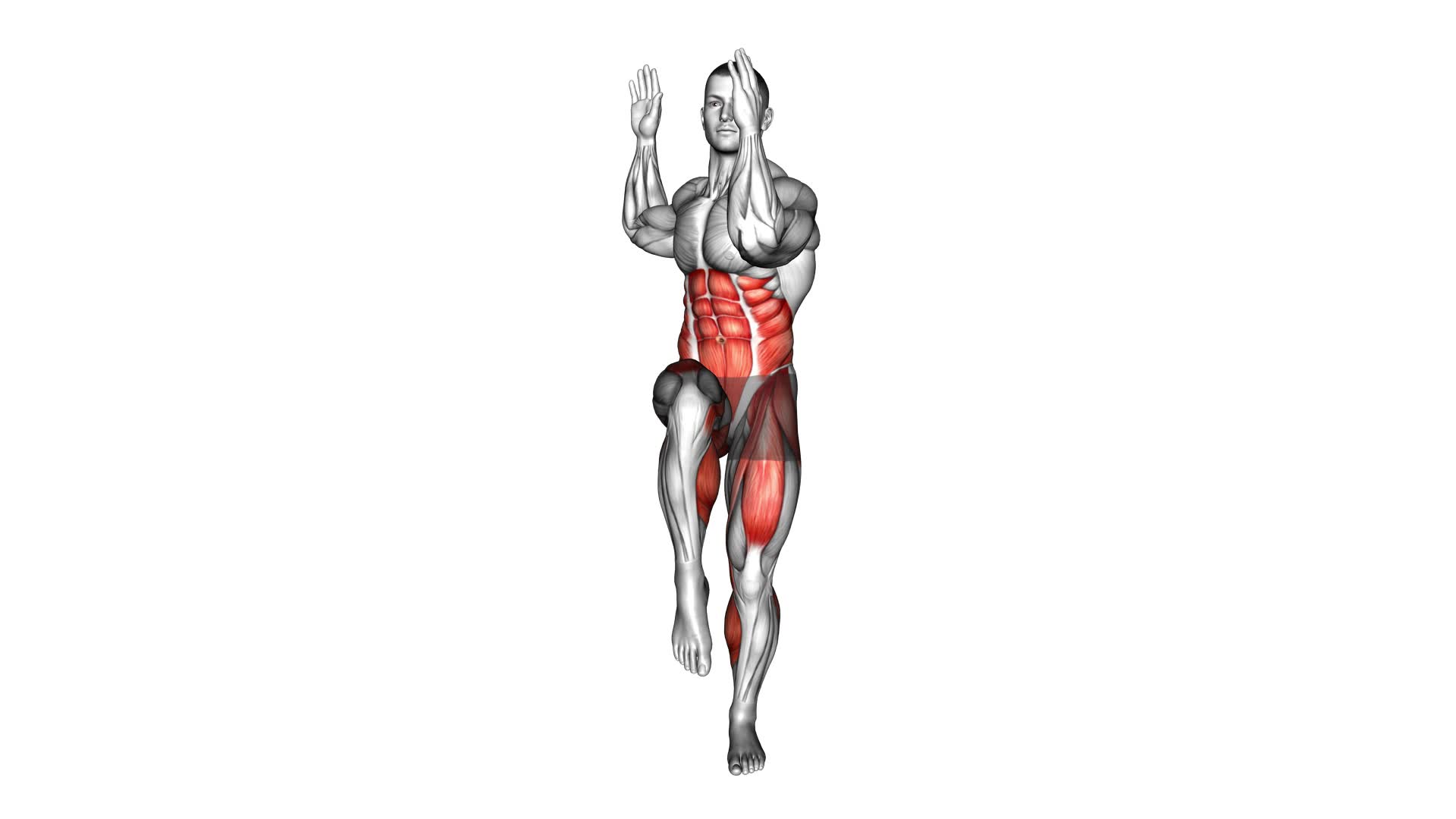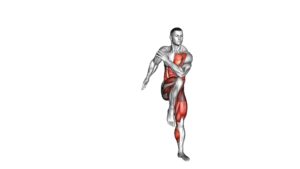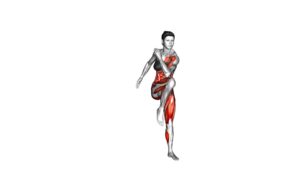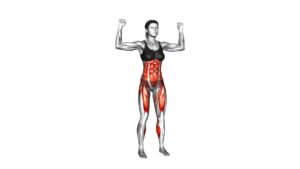Twisting Knee-up (male) – Video Exercise Guide & Tips

Are you looking for a challenging exercise that targets your core muscles? Look no further than the twisting knee-up!
Watch This Exercise Video
In this video exercise guide, we'll show you the proper form and equipment needed to perform this exercise effectively. Whether you're a beginner or an advanced practitioner, we've got you covered with modifications and tips to help you get the most out of your workout.
Let's get started and strengthen those abs!
Key Takeaways
- Proper form and technique are essential for performing the twisting knee-up exercise effectively and safely.
- Minimal equipment is required for this exercise, but modifications can be made to increase the challenge or accommodate different fitness levels.
- The twisting knee-up targets the abdominal muscles, specifically the obliques, and engages the hip flexors for stability and alignment.
- Incorporating knee stability exercises such as single-leg squats, lateral lunges, and step-ups can further strengthen the muscles around the knee joint and reduce the risk of injury.
Twisting Knee-up: Proper Form
To perform the twisting knee-up exercise correctly, start by standing with your feet shoulder-width apart. This exercise targets your abs, obliques, and hip flexors, and it can be modified to suit your fitness level.
Begin by lifting your right knee up towards your chest, while simultaneously twisting your torso to the right and bringing your left elbow towards your right knee. Return to the starting position and repeat on the other side. This is the basic twisting knee-up variation.
To add intensity, you can hold a medicine ball or dumbbell in your hands as you perform the exercise. The benefits of twisting knee-ups include improved core strength, increased stability, and enhanced coordination. They also help to tone and sculpt your abdominal muscles.
To maximize the effectiveness of this exercise, focus on maintaining proper form throughout the movement. Keep your core engaged, maintain a controlled pace, and avoid excessive swinging or jerking motions.
Twisting Knee-up: Equipment Needed
To perform the twisting knee-up exercise, you'll need minimal equipment. The great thing about this exercise is that it can be done with just a mat or a soft surface to lie on. This means that you can easily perform it at home or at the gym without the need for any special equipment.
However, if you prefer to have some support or variation, there are a few equipment options available. One option is to use an exercise ball. By placing the exercise ball between your legs and squeezing it as you lift your knees up, you can add an extra challenge to the exercise and engage your inner thighs as well. Another option is to use a resistance band. By looping the band around your thighs and pulling against it as you lift your knees up, you can increase the resistance and target your hip muscles even more.
The benefits of the twisting knee-up exercise are numerous. It primarily targets the abdominal muscles, specifically the obliques, which are responsible for rotating and stabilizing the spine. By twisting your knees to one side while lifting them up, you engage and strengthen these muscles, helping to improve your overall core strength and stability. Additionally, this exercise also engages the hip flexors, which are important for hip mobility and stability.
Twisting Knee-up: Muscles Targeted
Engaging your abdominal muscles and hip flexors, the twisting knee-up exercise targets key muscle groups for improved core strength and stability. By bringing your knees up towards your chest while simultaneously twisting your torso, you activate your rectus abdominis, obliques, and hip flexors. These muscles work together to stabilize your spine and pelvis, promoting better posture and reducing the risk of lower back pain.
The twisting motion also engages your internal and external obliques, which are responsible for rotational movements and side-to-side stability. Additionally, the twisting knee-up exercise challenges your hip flexors, which are important for maintaining knee stability and proper alignment during physical activities. Strengthening these muscles can enhance your overall athletic performance and help prevent knee injuries.
As you perform the twisting knee-up exercise, focus on maintaining proper form and control, ensuring that your movements are smooth and controlled.
Now, let's explore some common mistakes to avoid when performing the twisting knee-up exercise.
Twisting Knee-up: Common Mistakes to Avoid
To perform the twisting knee-up exercise correctly, beginners should focus on correcting their form. Common mistakes to avoid include swinging the legs instead of using controlled movements, and not engaging the core muscles throughout the exercise.
It's also important to prevent knee injuries by maintaining proper alignment and avoiding excessive twisting or jerking motions. To prepare for the exercise, it's recommended to warm up the body with dynamic stretches and mobility exercises.
Form Corrections for Beginners
Avoiding common mistakes is crucial when performing the twisting knee-up exercise as a beginner. By focusing on the correct form, you can maximize the benefits of this exercise while minimizing the risk of injury.
First, let's discuss the importance of proper form. Common knee injuries, such as sprains or strains, can occur if you don't execute the exercise correctly. To prevent these injuries, it's essential to maintain a stable core, engage your abdominal muscles, and avoid excessive twisting or jerking motions.
Additionally, incorporating twisting knee-up exercises into your workout routine can provide various benefits. This exercise targets your abs, obliques, and hip flexors, helping to strengthen and tone these muscles. It also improves your balance, stability, and overall core strength.
Preventing Knee Injuries
Are you aware of the common mistakes to avoid when performing the twisting knee-up exercise to prevent knee injuries? Proper form is crucial to prevent knee injuries and strengthen the knee muscles effectively. Here are some common mistakes to avoid:
- Poor alignment: Make sure your hips, knees, and ankles are in a straight line throughout the exercise.
- Over-rotation: Avoid excessive twisting of the knee joint to prevent strain and potential injury.
- Lack of core engagement: Engage your core muscles to provide stability and support to your knees during the exercise.
- Neglecting warm-up: Always warm up your body before performing any exercise to prepare your muscles and joints.
Proper Warm-Up Techniques
For proper warm-up techniques before performing the twisting knee-up exercise, it's important to engage in a series of dynamic movements to prepare your muscles and joints. Dynamic stretching is a key component of a warm-up, as it helps increase blood flow, improve flexibility, and reduce the risk of injury.
Incorporating movements that mimic the actions of the exercise, such as leg swings, hip circles, and torso twists, can help activate the muscles and joints involved in the twisting knee-up. By gradually increasing the intensity and range of motion during the warm-up, you can effectively prepare your body for the exercise.
Twisting Knee-up: Modifications for Beginners
To modify the twisting knee-up exercise for beginners, start by using a chair for support. This modification will help you build strength and stability before progressing to the full exercise. Here are some modifications that can be beneficial for beginners:
- Use a chair for support:
- Place a chair next to you and hold onto it with one hand. This will provide you with extra stability and support as you lift your knees.
- Reduce the range of motion:
- Instead of lifting your knees all the way up, start by lifting them halfway. As you build strength and confidence, gradually increase the range of motion.
Modifying the twisting knee-up exercise for beginners is important to prevent injuries and build a solid foundation. By using a chair for support and reducing the range of motion, you can gradually progress to the full exercise. Remember to listen to your body and only increase the difficulty when you feel ready.
As you become more advanced, you can explore different modifications and variations to challenge yourself further. The twisting knee-up exercise offers numerous benefits, such as improving core strength, stability, and flexibility. Incorporating these modifications will ensure a safe and effective workout for beginners.
Twisting Knee-up: Tips for Advanced Practitioners
Challenge yourself further with the twisting knee-up exercise by incorporating advanced modifications and techniques. These advanced variations won't only enhance the intensity of your workout but also target different muscle groups and improve knee stability.
To make the twisting knee-up more challenging, you can try adding ankle weights or holding a medicine ball between your knees. This will increase resistance and help build strength in your lower body.
Another advanced modification is to perform the exercise on an unstable surface, such as a Bosu ball or balance board. This will engage your core muscles even more as they work to stabilize your body during the movement.
In addition to the advanced modifications, incorporating knee stability exercises into your routine can help improve the effectiveness of the twisting knee-up. Exercises like single-leg squats, lateral lunges, and step-ups can strengthen the muscles around the knee joint, enhancing stability and reducing the risk of injury.
Remember to always maintain proper form and technique when performing advanced variations of the twisting knee-up. It's important to listen to your body and progress at a pace that's suitable for your fitness level.
Frequently Asked Questions
How Many Calories Can I Burn by Doing Twisting Knee-Up Exercises?
By doing twisting knee-up exercises, you can burn a significant number of calories. These exercises engage multiple muscle groups, increasing your heart rate and boosting your metabolism. However, the exact number of calories burned will vary depending on factors such as your weight, intensity level, and duration of the exercise.
To maximize calorie burning benefits, it's important to maintain proper form and technique throughout the exercise.
Is It Safe to Perform Twisting Knee-Up Exercises if I Have a Knee Injury?
If you have a knee injury, it's important to take precautions when performing twisting knee-up exercises.
Consult with a medical professional before attempting any exercise. They can provide guidance on modifications that may be necessary to protect your knee.
Twisting knee-up exercises can put strain on the knee joint, so it's crucial to listen to your body and stop if you experience pain or discomfort.
Remember to prioritize your safety and well-being during your workout routine.
How Often Should I Incorporate Twisting Knee-Up Exercises Into My Workout Routine?
To properly perform twisting knee-up exercises, start by lying on your back with your legs extended. Bend one knee and bring it toward your chest while simultaneously twisting your torso to the opposite side. Return to the starting position and repeat on the other side.
Incorporating these exercises into your workout routine can benefit you by targeting your core muscles and improving stability. However, it's important to listen to your body and not overdo it, especially if you have a knee injury.
Can I Do Twisting Knee-Up Exercises if I Don't Have Access to a Gym or Equipment?
Yes, you can definitely do twisting knee-up exercises even if you don't have access to a gym or equipment. There are plenty of home workout alternatives that you can try.
Bodyweight exercises, like twisting knee-ups, can be very effective in improving your core strength and stability. Plus, they don't require any special equipment.
Are There Any Alternative Exercises That Target the Same Muscles as Twisting Knee-Up?
If you're looking for alternative exercises that target the same muscles as twisting knee-ups, there are a few options you can try.
One modification you can make is to perform side plank hip dips, which engage similar muscles in your core and obliques.
Another option is bicycle crunches, which work your abs and obliques while also incorporating some twisting motion.
Both of these exercises can be done without the need for gym equipment, making them convenient alternatives to twisting knee-ups.
Conclusion
In conclusion, the twisting knee-up is a challenging exercise that targets the core muscles.
By following proper form and avoiding common mistakes, you can maximize the effectiveness of this exercise.
Beginners can modify the movement to suit their fitness level, while advanced practitioners can challenge themselves by incorporating additional variations.
Remember to consult a professional trainer or healthcare provider before attempting any new exercise routine.

Author
Years ago, the spark of my life’s passion ignited in my mind the moment I stepped into the local gym for the first time. The inaugural bead of perspiration, the initial endeavor, the very first surge of endorphins, and a sense of pride that washed over me post-workout marked the beginning of my deep-seated interest in strength sports, fitness, and sports nutrition. This very curiosity blossomed rapidly into a profound fascination, propelling me to earn a Master’s degree in Physical Education from the Academy of Physical Education in Krakow, followed by a Sports Manager diploma from the Jagiellonian University. My journey of growth led me to gain more specialized qualifications, such as being a certified personal trainer with a focus on sports dietetics, a lifeguard, and an instructor for wellness and corrective gymnastics. Theoretical knowledge paired seamlessly with practical experience, reinforcing my belief that the transformation of individuals under my guidance was also a reflection of my personal growth. This belief holds true even today. Each day, I strive to push the boundaries and explore new realms. These realms gently elevate me to greater heights. The unique combination of passion for my field and the continuous quest for growth fuels my drive to break new ground.







